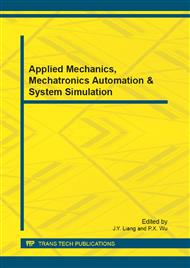[1]
Chen-Ming Li, Ming-Tsung Li: A Low-Power Self-Forward-Body-Bias CMOS LNA for 3–6. 5-GHz UWB Receivers, IEEE Microw. Wireless Compon. Lett., Vol. 20, No. 2, p.100–102, (2010).
DOI: 10.1109/lmwc.2009.2038526
Google Scholar
[2]
Y. -J. Lin, S. -H. Hsu, J. -D. Jin, and C. -Y. Chan: A 3. 1 10. 6-GHz ultrawideband CMOS LNA with current-reused technique, IEEE Microw. Wireless Compon. Lett., vol. 17, no. 3, p.232–234, (2007).
DOI: 10.1109/lmwc.2006.890503
Google Scholar
[3]
A. Bevilacqua and A. M. Niknejad: An ultra-wideband CMOS lownoise amplifier for 3. 1–10. 6-GHz wireless receivers, IEEE J. Solid- State Circuits, vol. 39, no. 12, p.2259–2268, (2004).
DOI: 10.1109/jssc.2004.836338
Google Scholar
[4]
C. -W. Kim, M. -S. Kang, P. -T. Anh, H. -T. Kim, and S. -G. Lee: An ultra-wideband CMOS LNA for 3–5-GHz UWB system, IEEE J. Solid-State Circuits, vol. 40, no. 2, p.544–547, February (2005).
DOI: 10.1109/jssc.2004.840951
Google Scholar
[5]
Wang Chu hua: A CMOS 3. 1-10. 6 GHz Merged UWB LNA and Mixer, 4th WiCOM, pp.1-4, (2008).
Google Scholar
[6]
Ahmed Amer , Emad Hegazi, and Hani F. Ragaie: A 90-nm Wideband Merged CMOS LNA and Mixer Exploiting Noise Cancellation, IEEE J. Solid-State Circuits, VOL. 42, NO. 2, pp.323-328, (2007).
DOI: 10.1109/jssc.2006.889374
Google Scholar
[7]
Wei-Hung Chen, Gang Liu: A Highly Linear Broadband CMOS LNA Employing Noise and Distortion Cancellation, IEEE J. Solid-State Circuits, VOL. 43, NO. 5, p.365–368, (2008).
DOI: 10.1109/jssc.2008.920335
Google Scholar
[8]
MacEachern, L. A., & Manku, T. : A charge-injection method for Gilbert-cell biasing, IEEE Canadian Conference on Electrical and Computer Engineering, 1, p.365–368, (1998).
DOI: 10.1109/ccece.1998.682760
Google Scholar
[9]
SOORAPANTH, T., and LEE, T.H. : RF linearity of short-channel MOSFETs. 1st international workshop on Design of mixed-mode integrated circuits and applications, Mexico, pp.81-84, (1997).
Google Scholar
[10]
Ting-Ping Liu, and Eric Westerwick: 5-GHz CMOS Radio Transceiver Front-End Chipset, IEEE JOURNAL OF SOLID-STATE CIRCUITS, VOL. 35, NO. 12, pp.1927-1933, (2000).
DOI: 10.1109/4.890306
Google Scholar
[11]
Jussi Ryynänen, Kalle Kivekäs, and Jarkko Jussila,: A Dual-Band RF Front-End for WCDMA and GSM Applications, IEEE J. Solid-State Circuits, Vol. 36, No. 8, pp.1198-1204, (2001).
DOI: 10.1109/4.938370
Google Scholar
[12]
Vojkan Vidojkovic. Johan van der Tang, Arjan Leeuwenburgh and Arthur van Roermund: MIXER TOPOLOGY SELECTION FOR A 1. 8 - 2. 5 GHZ MULTI-STANDARD FRONT-END IN 0. 18 μm CMOS, IEEE International Symposium on Circuits and Systems, v 2, pp.300-303, (2003).
DOI: 10.1109/iscas.2003.1205966
Google Scholar
[13]
T. Hui Teo, Wooi Gan Yeoh: Low-Power Short-Range Radio CMOS Subharmonic RF Front- End Using CG-CS LNA, IEEE Trans. On Circuits and Systems II, Vol. 55, No. 7, pp.658-662, (2008).
DOI: 10.1109/tcsii.2008.921578
Google Scholar


